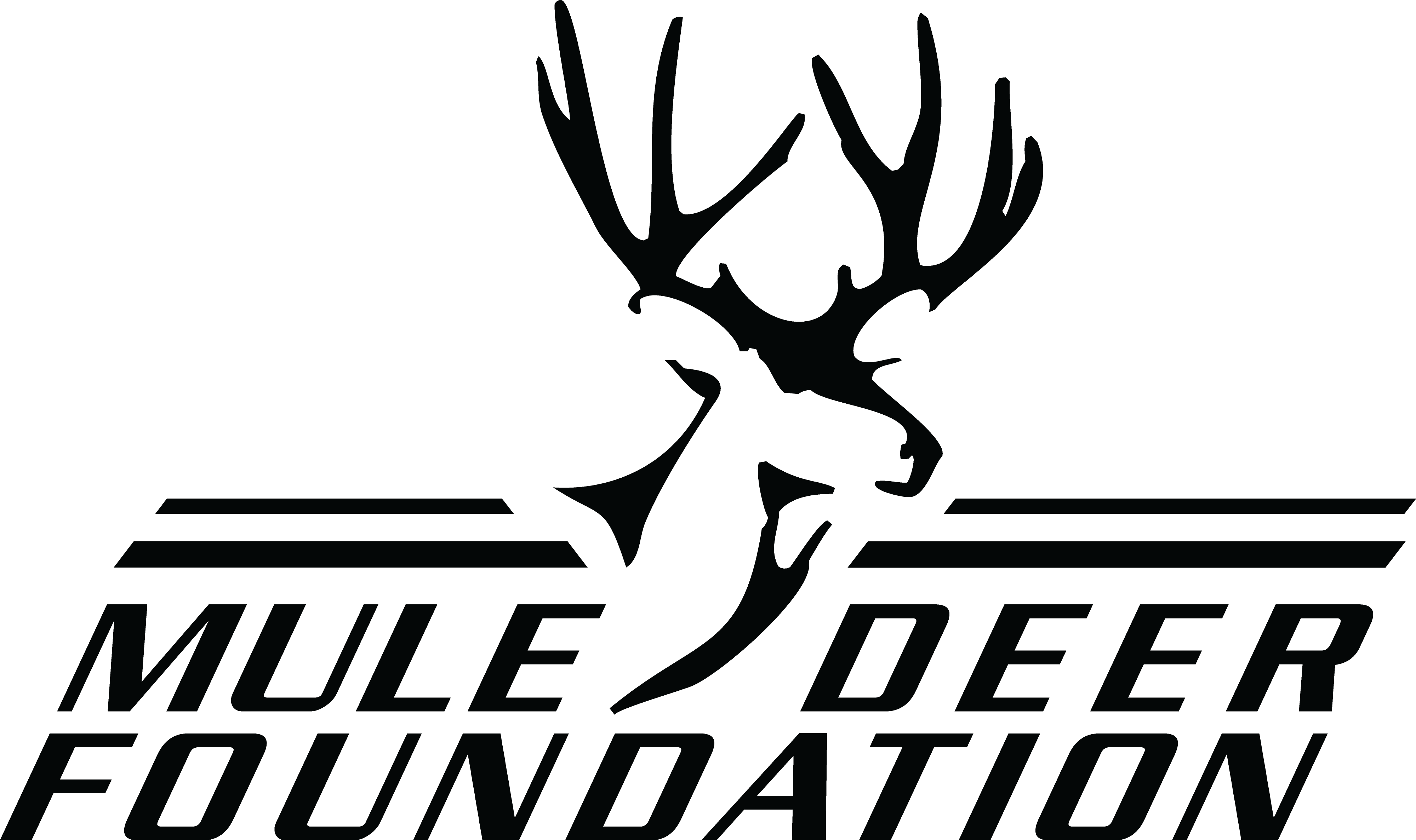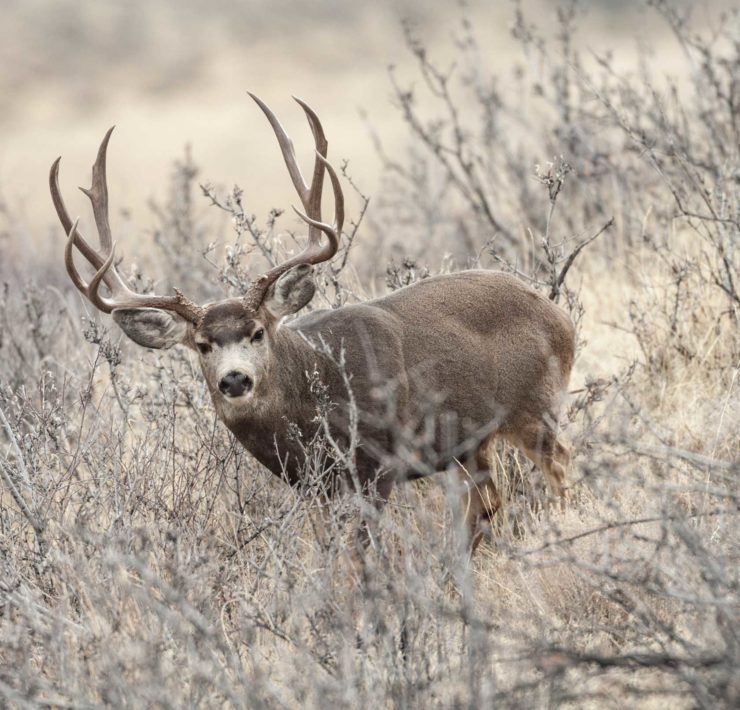North Dakota State Spotlight
The Mule Deer Foundation is the only conservation group in…
North Dakota State Spotlight
The mule deer population in North Dakota has struggled over the past five years due to Mother Nature, oil development in their prime habitat, increased highway traffic, and loss of lands enrolled in the Conservation Reserve Program. But, the Mule Deer Foundation chapters in North Dakota, the oil industry, and private landowners are working together to improve the situation in the western part of the state by restoring habitat. And with an influx of new funding for these habitat conservation projects, things are looking up for our Icon of the West
“We cannot control Mother Nature,” said North Dakota State Chair, Ryan Krapp, “But we sure can work to put positive effects on the ground to give the mule deer a fighting chance.”
Ryan Krapp, chapter members, and I have been working the past couple of years to create relationships with landowners, private land biologists, and the oil industry. These folks are on the ground, they have a stake in what is happening, and can assist in improving habitat in western North Dakota. Landowners are great stewards of the land, but being a good steward can cost a lot of money. This is where the Mule Deer Foundation and the oil industry come in, MDF chapters have been raising funds for mule deer habitat and the oil industry has expressed their desire to give back to the impacted counties. The problem has been identifying where we can make the biggest impact. With most of the land in Western ND being privately held, there is only so much that can be done on the few areas of public/state land.
Ryan and I had been looking for projects the past several years with not a lot of luck. We invested much of our funds into youth conservation/shooting events as well as sponsoring over 27,000 acres of Private Land Open To Sportsman land (PLOTS) with the ND Game and Fish (NDGF). These projects have been great, but they weren’t helping the mule deer. Finally, in 2013, Ryan set up a meeting with the NDGF Private Lands Biologist with the ND Game and Fish who shared an idea with us: Why not approach private landowners about habitat improvement projects on their land in return for PLOTS agreements or extensions? In this win-win-win situation, the landowner improves his habitat, which benefits grazing for their livestock, wildlife benefits from the improved habitat, and the sportsman and women of North Dakota get additional access.
However, the cost to cover many of the land use/habitat programs that are available through NDGF as well as the costs of actual habitat improvement are extremely high as conservation of habitat does not come cheap. We decided to approach the oil industry to help us put money on the ground – another win because the industry works with the landowners and these projects would give them a great opportunity to give back. Currently over 90% of the oil/gas development is occurring on private lands; therefore these are areas that are in the most need.
Ryan and I hit the pavement to start visiting with oil companies and the Private Lands biologists started combing thru their current PLOTS partners to identify lands that would benefit from improved habitat. We started our pilot project on the Kim Shade Ranch, 20 miles south of Medora. This project involved the prescribed burning of about 230 acres of juniper on the side of Tracy Mountain that was encroaching on natural grasslands. We were surprised by the costs, however, and we realized that we would have to move more slowly than we had anticipated, one project at a time.
Our work got a big boost when Governor Dalrymple signed the North Dakota Outdoor Heritage Fund in 2013. This new fund dedicates up to $30 million per biennium from oil and gas production tax revenue to provide grants to state agencies, tribal governments, political subdivisions, and nonprofit organizations to:
- Provide access to private and public lands for sportsmen, including projects that create fish and wildlife habitat and provide access for sportsmen;
- Improve, maintain, and restore water quality, soil conditions, plant diversity, animal systems, and to support other practices of stewardship to enhance farming and ranching;
- Develop, enhance, conserve, and restore wildlife and fish habitat on private and public lands; and
- Conserve natural areas for recreation through the establishment and development of parks and other recreation areas.
Ryan and I went to work putting together a grant proposal and a presentation for Outdoor Heritage Fund (OHF) advisory board for a September 2014 board meeting. Our proposed Western North Dakota Habitat Enhancement Projects would utilize OHF funds to protect, conserve, and enhance wildlife habitat on private and public lands in western North Dakota. The projects would allow MDF to partner with the NDGF Private Lands Initiative (PLI) program, the oil and gas industry, and other sportsman/conservation groups to enhance, improve, or rehabilitate habitats in western North Dakota, and would open access for sportsmen and women.
Building relationships with private producers on the land that supports the public wildlife resource would be critical for this initiative. MDF proposed to take the lead in reaching out to private landowners that may be interested in improving habitat to benefit wildlife while also improving the grazing opportunities on their land. There would be no cost to the landowner, but they would be asked for at least a three-year extension to their PLOTS agreement. These additional years would bring more access for ND sportsmen and women on enhanced habitats and hopefully the landowners would realize the mutual benefits and continue to be part of the PLOTS program for many years beyond.
MDF would also partner with other conservation groups (such as the Rocky Mountain Elk Foundation, the Wild Sheep Foundation, and the National Wild Turkey Federation) as well as with the ND Petroleum Council and energy industry businesses to cost-share on these habitat enhancement projects. Ron Ness, President of the ND Petroleum Council, was eager to get involved and put together a fishing tournament that raised $20,000 to assist in funding with the pilot project on the Kim Shade Ranch. In addition, Ness supported MDF in applying for a grant and also offered to assist with the writing of the grant proposal.
“The Outdoor Heritage Fund is a great example of bringing all stakeholders together to leverage state resources by developing private and non-profit partnerships to put the funds to work on conservation projects that are supported and implemented by the applicants. North Dakota’s oil industry is proud to be part of this process,” Ness said.
Our proposed goal in the next three years is to undertake at least six habitat enhancement/restoration projects on over 2,000 acres in western ND. These projects may involve a combination of prescribed burns, native grass and shrub plantings, weed control, fencing, and wildlife food plots. Projects would mainly occur on private lands enrolled or looking to be enrolled in the PLOTS program. We will also continue to work to develop projects with the State Land Department and NDGF on wildlife management areas. The results will be improved habitat for wildlife, increased sportsman access, as well as improving grazing conditions for western ND ranchers.
We figured that the cost of these efforts would be in the $700,000 range, and our grant request was for $480,000, or 65%-70% of the costs. We thought we had a great proposal since no other projects had been approved for western North Dakota and our plan was supported by the oil industry. However, when we made the presentation to the OHF advisory board, our grant request was declined. Though disappointed, we received a number of suggestions telling us that we were very close and needed to try again with some modifications. We took their advice and went back at the December OHF advisory board meeting and received a unanimous vote of support for the full amount of $480,000! Governor Dalrymple signed off on the grant in January of 2015.
Wade Moser, ND Stockman’s Association and chairman the OHF advisory board, reviewed our presentation: “The thing that really stood out with the MDF application was how many different parties it brought to the table. It was not a one-dimensional project, it will benefit different resources important to many user groups. It was the kind we like to see come before the Advisory Board that brought good ideas along with a contribution of dollars and professional technical expertise.”
Patricia Stockdill, Pheasants Forever and OHF advisory board member followed up saying, “The MDF grant benefits an array of wildlife species in North Dakota’s treasured Badlands. In addition, it brings together landowners, industry, and wildlife interests – and in North Dakota, that is what has to work together to enhance wildlife populations and wildlife habitat. It embraces what OHF is all about.”
These are great accolades, but now the real work begins. Currently, private land biologists are reaching out to landowners in Western ND and we have already met with two landowners with positive signs that they are willing to participate. One project would involve taking hundreds of acres back to native grasses for a period of at least six years.
“This grassland planting will provide additional fawning and foraging habitat for mule deer and pronghorn in the area. A more permanent grassland/shrubland habitat is needed to promote population growth of mule deer in secondary range,” said Bruce Stillings, ND Big Game Biologist. “This project will be a boost for both upland and big game in the area. Projects that enhance fawning and foraging habitat while providing public access will be beneficial to wildlife and sportsmen in the state.”
Another project may consist of replacing traditional barbed wire fencing in travel corridors with wildlife friendly fencing. The PLI biologists are just scratching the surface and we are very excited at the impact that we, with our partners in the oil industry, the Outdoor Heritage Fund, our conservation partners, and sponsoring members of MDF could have for our mule deer and other native wildlife. We hope by the time this article is published that one or two projects will have begun and we will be well on our way to improving habitat in western ND that will help our Icon of the West, the mule deer.
The Mule Deer Foundation is the only conservation group in North America dedicated to restoring, improving and protecting mule deer and black-tailed deer and their habitat, with a focus on science and program efficiency. MDF is a strong voice for hunters in access, wildlife management and conservation policy issues. MDF acknowledges regulated hunting as a viable management component and is committed to recruitment and retention of youth into the shooting sports and conservation. Get involved in your state or become a member at www.muledeer.org or call 1-888-375-3337.




